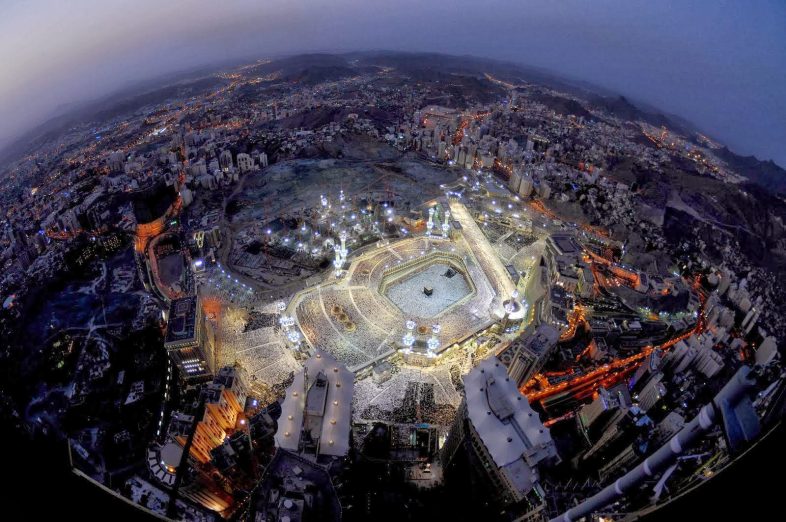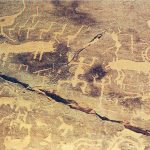Images by NASA
For Applied Biliteral Etymology the term “ancient” applies to the Stone Age. For sites and events to be ancient they must have a clearly attested biliteral root or a compound of the Dual Nuclei type, i.e. constructed of two identifcal biliteral roots, or a Nucleitic Compound constructed of two different biliteral roots.
Classical Arab exigists and historians seriously suggested that the Kaaba was built by “angels,” a claim that can be safely ignored. No such claim is made by the Quran but it is clear in claiming that “the first House (of worship) appointed for men was that at Bakka: Full of blessing and of guidance for all kinds of beings” (Aal-i-Imraan, 96).
The literal meaning of the Arabic word ka`bah (كَعْبَة) is “cube.”[7] The Kaaba of Mecca is called by many names in the Quran and Hadith, such as al-bayt (the house), al-bayt al-ḥarām (the sacred house), bayt Allāh (the house of God), al-bayt al-`atīq (the ancient house), and ’awwal bayt (the first house).
Etymology Workshop: Was Kaaba built by Angels?
According to supposedly religious sources, the Kaaba was built by “angels”. The Holy Quran didn’t say that but some of the interpreters of the Quran did. The origin of the name “Kabba” is probably 7,000+ years old. You can look it up in The Assyrian Dictionary of the Oriental Institute of the University of Chicago (CAD).
If you know the root?
Do you?
We do
the interpreters and an historically influential body named by some contemporary researchers of ancient religions The Industrial Religious Complex (IRC) also claims the Haram was the first home to be built in the world. The Holy Quran doesn’t say that. Had early humans knew how to build stone homes , they’d be found in eastern Africa not in Arabia.
The confusion is essentially linguistic. The IRC thought “beit” in the Holy Quran means any building. It does not. Had they thought of places like “Beit al Maqdes” (Jerusalem), Beit Laham, Beit Hanoon, all in Palestine, they would have realised the word “beit” at the time meant “a house of God”.
Is it the first “House of God”?
We have sufficient etymological evidence to indicate it pre-dates Sumerian temples in south Mesopotamia but we are looking again at Ṭaif, about 90 kilometres away. Legend has it Ṭaif was the location from which God is said to have ascended to Heaven.
The originator of the legend appears to be Kaab, a converted Jew who provided no other evidence except his word. Clearly this is not sufficient as several of his other statements cannot be true including his claim about the origin of Kaaba.
Islamic conviction aside, we believe the Quran has the most important documentation of the history of religion. The fact it says Arabians (Arabs’ ancestors and probably most of those in the Middle East and Europe) were at one time “one nation” before conflicts amongst them flared is supported by new theories related to the origin of of the ancient ‘Ariba, a prehistoric language known in academia as Proto-Semitic. This is explained by common roots of languages such as ancient Yemeni, Akkadian and some 70 other languages lumped together under “Afro-Asiatic Languages” linguistic jargon.
Another legend is being looked into claims the great Flood started in Taif. Curiously, maybe very curiously, Ṭaif and ‘tawf’ (t with a dot underneath) are from the same root, *ṬF “overflow”. ‘Ṭawf’ is “raft”. What do you make of that?
Aside from Taif, clay tablets found in Ugarit appear to support a legend of an extensive area between north Yemen and Mecca, and probably includes Taif, was a sacred place for God, and that he has an earthly home in it where fountains flow. A curious text in the Old Testament repeats something close.
The Quran has revealed three of the most important names in the history of religion some of the outstanding contributors to the Dictionary of Deities and Demons in the Bible would sell their cars to acquire. We should salute those contributors. Compared to them most of our Quran interpreters may be considered “people of khaf”, i.e. eternal sleepers.
We were surprised to find the Quranic stock of vocabulary more extensive than thought earlier and reflective of knowledge of ancient religious history. There are a number of Sumerian nouns including ‘aya’ and ‘sajad’, originally sag+d, and ‘sajar’, originally ‘sagar’. The hard ‘g’ is not in northern Arabic alphabet, and usually migrated to ‘j’. ‘Quran’ itself is from Akkadian: (qerû: [Human → Speech] to call, invite (to a meal, to offering, to battle); to call s.o. to his fate (i.e. have him die) D. to call up, invite) an ancient sister of ancient Arabic, and so is ‘sura’. Contrary to claims made by interpreters, Ibn Abbas one of them, we found no Persian or Abyssinian words. Claims that ‘Dirham’ is Greek turned out to be wrong, and Drachma itself appears to be Canaanite (dr = dust, hm = important, because silver was used as dust before struck into coins), classified by some as part of northern Arabic.
Our research continues. It is very complex and very millenniam and patience is more than a virtue.
Bishtawi is author of Origins of “Semitic” Languages, Origin of Arabic Numerals and Natural Foundations of Arabian Civilisation: Origins of alphabets, numeration, numerals, measurements and money.
www.bishtawi.com
Image: Komar?www.fotobehangposter.nl
Last modified: December 30, 2022



